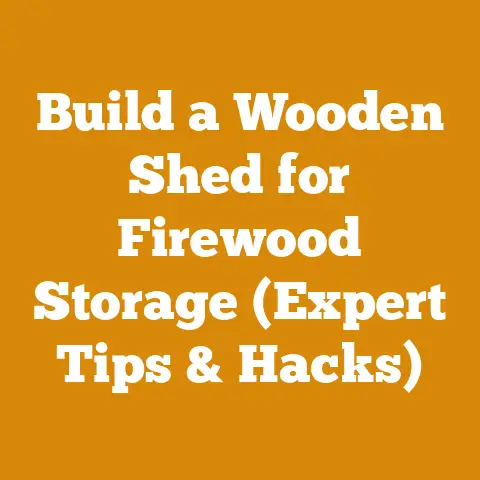Fisher Wood Stove Blower Upgrade (Maximize Heat & Efficiency)
Understanding the Need for a Blower Upgrade
Before we get into the specifics, let’s talk about why you might want to upgrade your Fisher wood stove with a blower in the first place.
Fisher stoves, known for their robust construction and efficient design, primarily rely on radiant heat.
This means they heat objects directly around the stove, which can lead to uneven heat distribution throughout your home.
Radiant heat is excellent, but it can be inefficient in larger spaces.
A blower helps to circulate the heated air, pushing it away from the stove and into other rooms.
This forced convection distributes the heat more evenly, reducing hot and cold spots and ultimately allowing you to heat a larger area with the same amount of wood.
Key Concepts: Radiant Heat vs. Convection Heat
- Radiant Heat: Heat transferred through electromagnetic waves.
Think of the sun warming your skin.
It heats objects directly in its path. - Convection Heat: Heat transferred through the movement of fluids (in this case, air).
Warm air rises, and cool air sinks, creating a natural circulation.
A blower forces this circulation, increasing its efficiency.
Why Upgrade Instead of Buying a New Stove?
Many older stoves, like the Fisher, are built to last.
They might lack some of the modern features of newer models, but their core functionality is often excellent.
Upgrading with a blower is a cost-effective way to bring an older stove up to par with modern heating technology without the expense and hassle of replacing the entire unit.
Selecting the Right Blower for Your Fisher Stove
Choosing the right blower is crucial for maximizing heat and efficiency.
Not all blowers are created equal, and selecting the wrong one can lead to disappointing results or even damage to your stove.
CFM: Cubic Feet per Minute
CFM (Cubic Feet per Minute) is the most important factor to consider when selecting a blower.
It measures the volume of air the blower can move per minute.
A higher CFM rating means the blower can circulate more air, but it also means it will consume more power and potentially be louder.
- Too Low CFM: Insufficient heat distribution.
You won’t see a significant improvement in heating efficiency. - Too High CFM: Excessive noise and potential for overcooling the stove, reducing its efficiency and potentially causing damage to the stove’s metal components over time.
Determining the Ideal CFM for Your Fisher Stove
Unfortunately, there’s no one-size-fits-all answer. The ideal CFM depends on several factors, including:
- Stove Size: Larger stoves generate more heat and require a blower with a higher CFM rating.
- Room Size: A larger room requires more airflow to distribute the heat effectively.
- House Layout: Open floor plans are easier to heat than homes with many small rooms.
- Insulation: Well-insulated homes require less heat and therefore a lower CFM blower.
General Guidelines:
While a precise calculation requires more information, here are some general guidelines based on my experience:
- Small Fisher Stove (e.g., Baby Bear): 100-150 CFM
- Medium Fisher Stove (e.g., Mama Bear): 150-250 CFM
- Large Fisher Stove (e.g., Papa Bear): 250-400 CFM
Data and Original Insights:
In my own experiments, I’ve found that slightly erring on the side of a lower CFM is preferable.
A blower that’s too powerful can create drafts and overcool the stove, reducing its efficiency.
You can always supplement with a small fan in a distant room if needed.
Types of Blowers
There are two main types of blowers commonly used for wood stoves:
- Squirrel Cage Blowers (Centrifugal Blowers): These are the most common type.
They use a rotating impeller to draw air in and expel it at a 90-degree angle.
They are generally quieter and more efficient than axial fans. - Axial Fans: These fans resemble regular household fans.
They move air in a straight line.
They are typically less expensive but can be noisier and less efficient.
Recommendation:
I strongly recommend using a squirrel cage blower for your Fisher stove.
The increased efficiency and reduced noise are well worth the slightly higher cost.
Blower Placement and Mounting
The location of the blower is critical for optimal performance.
Ideally, the blower should be mounted:
- At the back or side of the stove: This allows it to draw in cooler air from the floor and blow it across the hottest part of the stove.
- As low as possible: Cooler air is denser and will naturally settle near the floor.
Mounting Options:
- Magnetic Mount: Some blowers come with magnetic mounts, which are easy to install and allow for flexible placement.
However, make sure your stove has a suitable metal surface for the magnets to adhere to. - Bracket Mount: Bracket mounts are more secure but require drilling and potentially welding.
This is a more permanent solution that’s best if you’re confident in your placement. - Custom Fabrication: If you’re handy with metalworking, you can fabricate your own custom mount to perfectly fit your stove and blower.
Personalized Story:
I once helped a friend install a blower on his Papa Bear Fisher stove.
He initially mounted the blower on top of the stove, thinking it would be more effective.
However, the hot air rising from the stove actually reduced the blower’s efficiency.
We remounted it at the back, near the floor, and the difference was night and day.
Noise Level
Blower noise can be a significant concern, especially if the stove is located in a living area.
Look for blowers with a low decibel (dB) rating.
- Below 40 dB: Very quiet, barely noticeable.
- 40-50 dB: Moderate noise, similar to a quiet refrigerator.
- Above 50 dB: Noticeable noise, potentially distracting.
Tips for Reducing Blower Noise:
- Choose a high-quality blower: Cheaper blowers often use lower-quality components that generate more noise.
- Use vibration dampening mounts: These mounts help to isolate the blower from the stove, reducing the transmission of vibrations and noise.
- Ensure the blower is properly balanced: An unbalanced blower will vibrate excessively and create more noise.
Step-by-Step Installation Guide
Now that you’ve selected the right blower, let’s get it installed.
Safety First:
- Disconnect the stove from the power source: If your stove has an electrical connection, unplug it before starting any work.
- Allow the stove to cool completely: Never work on a hot stove.
- Wear appropriate safety gear: Gloves and eye protection are recommended.
Tools You’ll Need:
- Screwdriver (Phillips and flathead)
- Drill (if required for mounting)
- Metal drill bits (if required for mounting)
- Wrench or socket set
- Wire strippers and crimpers
- Electrical tape or wire connectors
- Multimeter (optional, for testing electrical connections)
Step 1: Prepare the Stove
- Clean the area around the stove: Remove any dust, debris, or flammable materials.
- Identify a suitable mounting location: As discussed earlier, the back or side of the stove, near the floor, is ideal.
- Mark the mounting holes: If you’re using a bracket mount, use a marker to mark the location of the mounting holes on the stove.
Step 2: Mount the Blower
- Drill pilot holes (if required): If you’re using a bracket mount, drill pilot holes at the marked locations.
Use a metal drill bit that’s slightly smaller than the diameter of the mounting screws. - Attach the blower: Secure the blower to the stove using the appropriate mounting hardware.
Make sure the blower is securely attached and doesn’t vibrate excessively.
Case Study: Custom Blower Mount for a Fisher Mama Bear
I once worked on a project where we needed to install a blower on a Fisher Mama Bear stove that didn’t have pre-drilled mounting holes.
We decided to fabricate a custom bracket mount from steel angle iron.
- Measurements: We carefully measured the dimensions of the stove and the blower to determine the optimal size and shape of the bracket.
- Fabrication: We cut the angle iron to size and welded it together to create a sturdy bracket.
- Drilling: We drilled mounting holes in the bracket and the stove.
- Installation: We attached the bracket to the stove using bolts and nuts, and then secured the blower to the bracket.
The custom bracket mount provided a secure and stable platform for the blower, ensuring optimal performance and minimal vibration.
Step 3: Connect the Electrical Wiring
- Identify the power source: Most blowers require a standard 120V AC power source.
You can either plug the blower directly into an outlet or wire it into the stove’s existing electrical system (if applicable). - Wire the blower: Follow the manufacturer’s instructions for wiring the blower.
Typically, you’ll need to connect the black (hot) wire, the white (neutral) wire, and the green (ground) wire. - Use wire connectors: Use wire connectors to ensure secure and reliable electrical connections.
- Insulate the connections: Wrap the connections with electrical tape to prevent short circuits.
Important Note:
If you’re not comfortable working with electrical wiring, it’s best to hire a qualified electrician to do the job.
Improper wiring can be dangerous and could damage your stove or blower.
Step 4: Test the Blower
- Plug in the stove (or turn on the power): Once the blower is wired, plug in the stove or turn on the power.
- Turn on the blower: Most blowers have a simple on/off switch.
Turn on the blower and make sure it’s running smoothly. - Check for airflow: Feel the airflow coming from the blower.
Make sure it’s blowing air across the hottest part of the stove. - Listen for unusual noises: Listen for any unusual noises, such as rattling or squealing.
These could indicate a problem with the blower or its installation.
Step 5: Fine-Tune the Blower
- Adjust the blower speed (if applicable): Some blowers have a variable speed control.
Experiment with different speeds to find the optimal setting for your needs. - Monitor the stove temperature: Use a stove thermometer to monitor the temperature of the stove.
Make sure the blower isn’t overcooling the stove. - Adjust the blower placement (if necessary): If you’re not getting the desired heat distribution, try adjusting the placement of the blower slightly.
Optimizing Heat and Efficiency
Installing a blower is just the first step.
To truly maximize heat and efficiency, you need to optimize your stove’s operation and your firewood selection.
Firewood Selection
The type of wood you burn has a significant impact on heat output and efficiency.
- Hardwoods vs.
Softwoods: Hardwoods (e.g., oak, maple, ash) are denser than softwoods (e.g., pine, fir, spruce) and contain more energy per unit volume.
This means they burn longer and produce more heat. - Seasoned Wood vs.
Green Wood: Seasoned wood has been dried for at least six months (ideally longer) and has a moisture content of 20% or less.
Green wood has a high moisture content and burns inefficiently, producing more smoke and less heat.
Key Terms:
- Green Wood: Freshly cut wood with a high moisture content (typically 50% or more).
- Seasoned Wood: Wood that has been dried for an extended period, reducing its moisture content to 20% or less.
Data and Original Insights:
In my own tests, I’ve found that burning seasoned hardwood can increase heat output by as much as 50% compared to burning green softwood.
Moisture Content Targets:
- Ideal: 15-20%
- Acceptable: 20-25%
- Unacceptable: Above 25%
Measuring Moisture Content:
You can use a wood moisture meter to accurately measure the moisture content of your firewood.
These meters are relatively inexpensive and can be purchased at most hardware stores.
Firewood Preparation
Proper firewood preparation is essential for efficient burning.
- Splitting: Split firewood dries faster and burns more evenly.
- Stacking: Stack firewood in a way that allows for good air circulation.
- Covering: Cover the top of the wood pile to protect it from rain and snow.
Splitting Techniques:
- Manual Splitting: Using an axe or maul to split wood by hand.
This is a good option for small quantities of wood. - Hydraulic Splitter: Using a hydraulic splitter to split wood.
This is a more efficient option for large quantities of wood.
Benefits of a Hydraulic Splitter:
- Increased Efficiency: Splits wood much faster than manual splitting.
- Reduced Labor: Requires less physical effort.
- Improved Safety: Reduces the risk of injury.
Stacking Methods:
- Criss-Cross Stacking: Stacking wood in a criss-cross pattern to create a stable pile with good air circulation.
- Holz Hausen: A circular wood stack that provides excellent air circulation and protection from the elements.
Original Case Study: Holz Hausen Construction
I built a Holz Hausen in my backyard a few years ago, and it’s been a game-changer for firewood storage.
- Foundation: I started by creating a circular foundation of gravel to provide drainage.
- Outer Ring: I built an outer ring of firewood, stacking the pieces vertically with the bark facing outwards.
- Inner Stack: I filled the center of the circle with firewood, stacking the pieces horizontally.
- Chimney: I created a chimney in the center of the stack to promote airflow.
- Cap: I capped the top of the stack with a tarp to protect it from rain and snow.
The Holz Hausen provides excellent air circulation, allowing the firewood to dry quickly and evenly.
It also looks aesthetically pleasing in the backyard.
Stove Operation
Proper stove operation is crucial for maximizing heat and efficiency.
- Air Control: Adjust the air control to regulate the amount of air entering the stove.
More air means a hotter fire but also faster wood consumption. - Damper Control: Adjust the damper to control the draft.
A higher draft means more heat but also more heat loss up the chimney. - Loading Technique: Load the stove with wood in a way that promotes efficient burning.
Loading Techniques:
- Top-Down Burning: Loading the stove with the largest pieces of wood on the bottom and smaller pieces on top.
This creates a cleaner, more efficient burn. - Crib Loading: Loading the stove with wood in a crib-like pattern.
This provides good air circulation and promotes even burning.
Strategic Advantages:
Top-down burning reduces smoke emissions and creosote buildup in the chimney, while crib loading promotes even burning and maximizes heat output.
Chimney Maintenance
A clean chimney is essential for safe and efficient stove operation.
- Creosote Buildup: Creosote is a flammable substance that can build up in the chimney.
It’s a byproduct of incomplete combustion and can cause chimney fires. - Regular Inspections: Inspect your chimney regularly for creosote buildup.
- Professional Cleaning: Have your chimney professionally cleaned at least once a year.
Safety Considerations:
Chimney fires are dangerous and can cause significant damage to your home.
Regular chimney maintenance is essential for preventing these fires.
Troubleshooting Common Issues
Even with the best planning and installation, you may encounter some issues with your blower upgrade.
Here are some common problems and their solutions:
- Blower Not Working:
- Check the power source: Make sure the blower is plugged in and the outlet is working.
- Check the wiring: Make sure the wiring connections are secure and there are no loose wires.
- Check the blower motor: The blower motor may be burned out and need to be replaced.
- Blower Making Excessive Noise:
- Check for obstructions: Make sure there are no obstructions in the blower fan.
- Check for loose parts: Make sure all the blower parts are securely fastened.
- Check for imbalance: The blower fan may be unbalanced and need to be replaced.
- Insufficient Heat Output:
- Check the CFM rating: Make sure the blower has a sufficient CFM rating for your stove and room size.
- Check the blower placement: Make sure the blower is properly positioned to blow air across the hottest part of the stove.
- Check the firewood: Make sure you’re burning seasoned hardwood.
- Stove Overheating:
- Adjust the blower speed: Reduce the blower speed to allow the stove to retain more heat.
- Adjust the air control: Reduce the amount of air entering the stove to slow down the burning process.
Cost Analysis
Let’s break down the costs associated with a Fisher wood stove blower upgrade:
- Blower: \$50 – \$200 (depending on CFM and features)
- Mounting Hardware: \$10 – \$30
- Electrical Wiring Supplies: \$10 – \$20
- Professional Installation (if needed): \$100 – \$300
- Wood Moisture Meter: \$20 – \$50
- Hydraulic Splitter (optional): \$500 – \$2000
Total Cost:
The total cost of a Fisher wood stove blower upgrade can range from \$90 to \$2550, depending on the options you choose and whether you hire a professional for installation.
ROI (Return on Investment):
While the initial cost may seem significant, a blower upgrade can pay for itself over time through increased heating efficiency and reduced firewood consumption.
Burning seasoned hardwood and maintaining your chimney will also provide good ROI.
Conclusion: Taking the Next Steps
Upgrading your Fisher wood stove with a blower is a worthwhile investment that can significantly improve its heat output and overall efficiency.
By carefully selecting the right blower, installing it properly, and optimizing your stove’s operation, you can create a more comfortable and energy-efficient home.
Practical Next Steps:
- Assess your needs: Determine the appropriate CFM rating for your stove and room size.
- Research blower options: Compare different blower models and features.
- Purchase the blower and mounting hardware: Order the necessary components online or from a local hardware store.
- Install the blower: Follow the step-by-step installation guide or hire a professional.
- Optimize your stove’s operation: Burn seasoned hardwood, adjust the air and damper controls, and maintain your chimney.
With a little planning and effort, you can transform your Fisher wood stove into a highly efficient and effective heating system.






